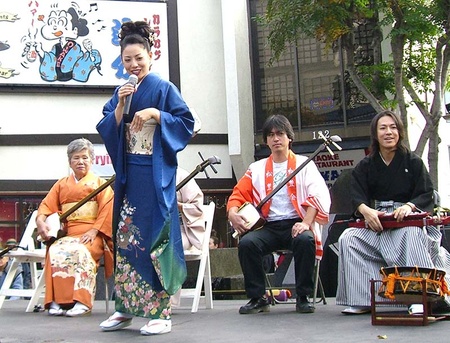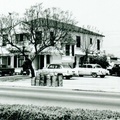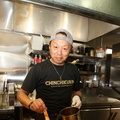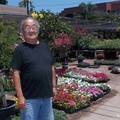I had mixed feelings of anxiety and excitement as I drove to a theater in San Pedro, the concert venue, wondering what kind of show was waiting for me. It was “Fusion Minyo (Japanese folk music)”—to be performed by Minyo Station, a group led by Marisa Kosugi. I’d gotten a glimpse of them once on DVD before, but it was my first time seeing them live in a concert. To be honest, I was thinking that the fusion of minyo would be something very difficult to achieve.
In fact, I had seen Marisa, together with her mother Matsutoyo Sato, head of Japanese Minyo “Matsutoyokai” at a variety of Japanese cultural events and gatherings of Nikkei organizations. Thirteen years ago, when she came back to the US after finishing her training in Japan with her natori (master’s license with stage name), I even had a chance to interview her. I was remembering all those things as I was driving.
Born in Berkeley in Northern California as a Nisei, Marisa grew up listening not only to Japanese folk music, but many kinds of music in America. She had learned singing and shamisen from her mother from a young age, but she gradually moved away from minyo as she entered her teens. As her American friends showed no interest in minyo, she wanted to do something she could do with her peers.
Still, Matsutoyo-san (her mother) sent Marisa to Japan for sightseeing when she turned 17. There Marisa ended up spending two months in the world of professional minyo. Marisa was in love with minyo by the time she came back. Four years later, she decided to go to Japan again and had three years of full training. Upon her return, she spent days with her mother like an angya (pilgrimage).
When I arrived at Grand Annex, their concert venue, I saw more than 100 people waiting—most of them were non-Nikkei Americans. Since it was the first concert of Minyo Station, established in January the year before, perhaps the group had invited their friends and acquaintances.
On the stage were the members of Matsutoyo Group and the musicians from Minyo Station. While Matsutoyo Group had shamisen and kane, Minyo Station had guitars, basses, and drums. And Marisa was the singer. Their attire was different, too: Matsutoyo Group members were in kimono and Minyo Station was dressed in T-shirts and long coats.
In fact, Matsutoyo Sato was the one who thought about having this style of minyo in the first place. She has lived with minyo for nearly 50 years. She moved to the US at age 25 and has been working to teach and spread minyo since she established the Matsutoyo Group in 1966. It was almost 20 years ago when she started thinking about mixing Western music and minyo as she knew that she had to appeal to younger people in order to pass along minyo onto the next generation. She had a hard time making her wish come true, yet finally she was able to achieve it through Marisa’s network of friends as she never gave up. It was her 20 years of dreaming come true.
The concert had two parts: the first part was dedicated to Minyo Station alone, and the second part was a collaboration with guest performers. The first part started with ringo-bushi from Aomori, and I found myself hesitating to enjoy the music. As they moved on to play aizu-bandaisan and kaigara-bushi, though, I was able to listen to the music calmly. Then came isohara-bushi performed by singing and the guitar. I realized that I was finding comfort in the music. It was a new style of music, yet had a sense of minyo in it.
The vocals were performed by Marisa, and the guitar was played by another core member of Minyo Station by the name of Yu Ooka. Since he moved to the US in 2006, Ooka, who’s from Osaka, has performed music (mainly jazz) with famous musicians, and he wrote the arrangement of minyo.
The slow tempo of isohara-bushi might have helped, too. But even more than that, I was impressed by Marisa Kosugi, a Nikkei bearer of Japanese folk music. She created her own performance group and sang the heart of minyo out to the audience in a much more relaxed state with a much more suitable style of music. Performing in front of me was a woman who had grown to be a mature artist with the help of her minyo music. Having gone through marriage and divorce, she had gained much bigger and deeper perspectives on life. “Minyo is what connects me to my mother. Otherwise, I wouldn’t be doing it,” Marisa stated clearly.
“I want to show respect for what my mother has been doing for over 40 years. It used to be something that I did as part of daily routine, but my appreciation has grown bigger and bigger. And I have the same feelings for other groups who perform minyo. Everyone is working hard to leave behind a good legacy, and I want to show my appreciation for it. Now I feel like I’ve come to understand the reason why I do minyo.”
I had an impression that minyo for Marisa had become something that she embraces as part of her that keeps her going in life. Of course, her age added a mature taste to that as well, as she will turn 37 this year (2009).
In the second part of the concert, Matsutoyo-san appeared on the stage as one of the guest performers. Invite Matsutoyo-san—her mother and teacher—as a guest. This has never been done on the stage of Matsutoyo Group. Marisa was able to do it for the first time, precisely because it was Minyo Station’s concert. And it was her way of showing appreciation for her mother who had always shown respect for her daughter before anything else.
*This article was originally written in Japanese and has been reprinted from TV Fan (May, 2009).
© 2009 Yukikazu Nagashima







